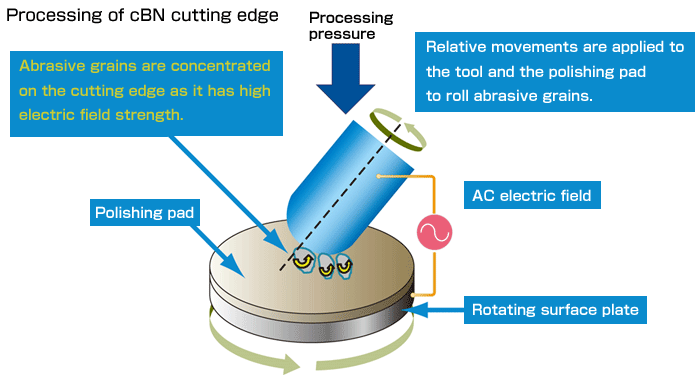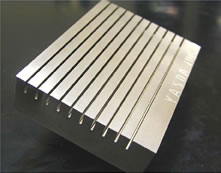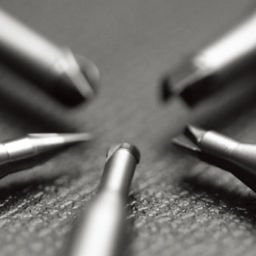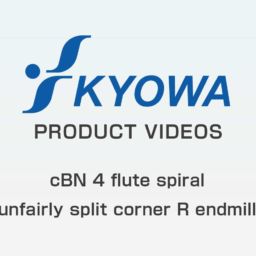Technical
December 8, 2014
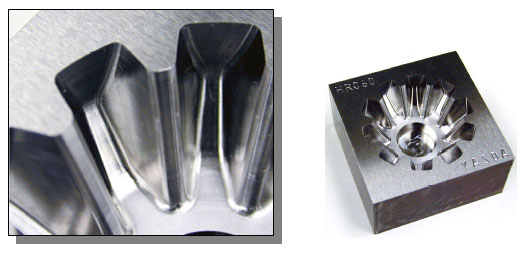
Advantages of cBN tools in hardened steel machining
Proper cutting work
requires a tool that is three times harder than the work material!

Characteristics of cBN end mill

Concept of cBN end mill
Innovation from electrical discharge machining to direct milling
- Reduced delivery time Example: Previously, 5 days for mold designing + 5 days for electrode processing + 5 days for electrical discharging/finishing, or 15 days in total. Presently, 5 days for mold designing + 1 day for direct milling, or 6 days in total.
- Reduced cost (75% reduction in power consumption, and no need for electrode fabrication) → Resource savings
- No drain from electrical discharge machining (0 → Eco-friendly)
Cuts two times faster and lasts five times longer than carbide-coated tools.
- Reduced machining time
- Fewer changes of tools during long period of cutting
- Less time for polishing process
Direct milling vs. electrical discharge machining
| Workpiece | Bevel gear cavity (60×60×50) |
| Work material | DC53 (HRC60) |
| Processing machine | Yasuda Precision Tools YBM640V |
| Cutting fluid | Oil mist (cBN for dry machining) |
| Tools used | Five carbide end mills, eight R1s, one cBN end mill |
| Machining description | Machining test by direct milling with carbide tools and cBN tool. (Time and surface roughness compared with conventional electrical discharge machining) |
| Cutting conditions | ||||
| Machining process | Tool used | Rotational frequency (min−1) | Feed (mm/min) | Machining time (min) |
| Prepared hole machining | Carbide R5 ball end mill | 600 | 240 | 7.4 |
| Roughing | Carbide φ10 end mill | 4,000 | 2,500 | 6.2 |
| Semi-roughing | Carbide R3 ball end mill | 5,000 | 1,200 | 19.0 |
| Semi-finishing | Carbide R1.5 ball end mill | 8,500 | 2,000 | 36.1 |
| Semi-finishing | Carbide R1.0 ball end mill | 15,000 | 2,400 | 28.5 |
| Final finishing | cBN R1.0 ball end mill | 20,000 | 2,000 | 50.3 |
| Prepared hole machining | Carbide R5 ball end mill | 600 | 240 | 7.4 |
| Roughing | Carbide φ10 end mill | 4,000 | 2,500 | 6.2 |
| Semi-roughing | Carbide R3 ball end mill | 5,000 | 1,200 | 19.0 |
| Semi-finishing | Carbide R1.5 ball end mill | 8,500 | 2,000 | 36.1 |
| Semi-finishing | Carbide R1.0 ball end mill | 15,000 | 2,400 | 28.5 |
| Final finishing | cBN R1.0 ball end mill | 20,000 | 2,000 | 50.3 |
Conclusion:
Approx. 10 h with conventional method (electrical discharge machining + polishing) vs. approx. 2.5 h with direct milling method
This translates to a 75% reduction in time.
Features of our CBN tool: Electrolytic abrasive grain polishing
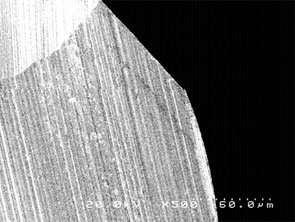
Unprocessed product (Grinding stone traces are seen, with the likelihood of causing surface accuracy deterioration and chipping.)
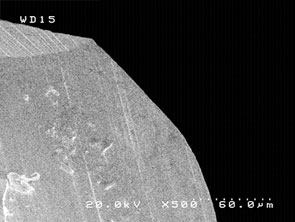
Processed product (The smooth cutting edge provides high accuracy and long life.)
